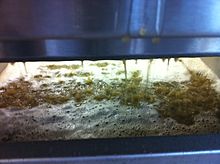
Rasteau is an Appellation d'Origine Contrôlée for wine in the southern Rhône wine region of France, covering both fortified and unfortified wines. The sweet fortified wines can be red, rosé or white, and have long been produced under the Rasteau AOC. In 2010 dry red wines (unfortified) were also added to the appellation, effective from the 2009 vintage.

Côtes-du-Rhône Villages is a French wine Appellation d'Origine Contrôlée (AOC) in the southern Rhône wine region of France. Red, white and rosé wine are all produced within the appellation. The quality is superior to the generic Côtes-du-Rhône AOC, but below more specific appellations such as Châteauneuf-du-Pape AOC and Vacqueyras AOC. Côtes-du-Rhône Villages is the second largest appellation in the Rhône, only surpassed in size by Côtes-du-Rhône AOC.

Chambertin is an Appellation d'origine contrôlée (AOC) and Grand Cru vineyard for red wine in the Côte de Nuits subregion of Burgundy, with Pinot noir as the main grape variety. Chambertin is located within the commune of Gevrey-Chambertin, and it is situated approximately in the centre of a group of nine Grand Cru vineyards all having "Chambertin" as part of their name. The other eight vineyards, which all are separate AOCs, have hyphenated names where Chambertin appears with a prefix, such as Chapelle-Chambertin. Chambertin itself is situated above the Route des Grands Crus. It borders on Chambertin-Clos de Bèze in the north, Griotte-Chambertin and Charmes-Chambertin in the east and the Latricières-Chambertin in the south. The AOC was created in 1937.

Chambertin-Clos de Bèze is an Appellation d'origine contrôlée (AOC) and Grand Cru vineyard for red wine in the Côte de Nuits subregion of Burgundy, with Pinot noir as the main grape variety. Chambertin-Clos de Bèze is located within the commune of Gevrey-Chambertin, together with a group of nine Grand Cru vineyards all having "Chambertin" as part of their name. It is located uphill from the Route des Grands Crus, borders on Chambertin in the north, Griotte-Chambertin and Chapelle-Chambertin in the east and Mazis-Chambertin in the north. The AOC was created in 1937.
Musigny, sometimes referred to as Le Musigny, is an Appellation d'origine contrôlée (AOC) and Grand Cru vineyard for red and white wine in Côte de Nuits of Burgundy. It is located within the commune of Chambolle-Musigny, to the south of the village itself. It borders on the Grand Cru Clos de Vougeot in the southeast, the Grand Cru Échezeaux in the south, and the Premier Cru Les Amoureuses in the northeast. The name is derived from a family de Musigny which is now extinct, but which held offices in the court of the Dukes of Burgundy from the 14th century. The AOC was created in 1936, but the borders of Musigny were previously set down legally in 1929.

Santenay wine is produced in the communes of Santenay and Remigny in Côte de Beaune of Burgundy. The Appellation d'origine contrôlée (AOC) Santenay may be used for red and white wine with respectively Pinot noir and Chardonnay as the main grape variety. The production consists of almost 85% red wine, and a little over 15% of white wine. There are no Grand Cru vineyards within the Santenay AOC.

Mercurey wine is produced in the communes of Mercurey and Saint-Martin-sous-Montaigu in the Côte Chalonnaise subregion of Burgundy. The Appellation d'origine contrôlée (AOC) Mercurey may be used for red and white wine with respectively Pinot noir and Chardonnay as the main grape variety. The production of red wine dominates, with almost 80 per cent.

Meursault wine is produced in the commune of Meursault in Côte de Beaune of Burgundy. The Appellation d'origine contrôlée (AOC) Meursault may be used for white wine and red with respectively Chardonnay and Pinot noir as the main grape varieties. The production of white Meursault dominates, with around 98 per cent. There are no Grand Cru vineyards within Meursault, but several highly regarded Premier Cru vineyards.
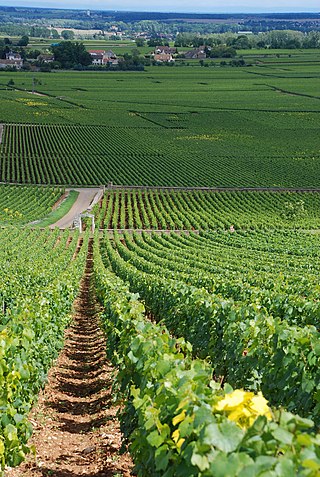
Puligny-Montrachet wine is produced in the commune of Puligny-Montrachet in Côte de Beaune of Burgundy. The Appellation d'origine contrôlée (AOC) Puligny-Montrachet may be used for white wine and red with respectively Chardonnay and Pinot noir as the main grape variety. However, almost only white Puligny-Montrachet is produced, at around 99.5 per cent of the total production. There are four Grand Cru vineyards within Puligny-Montrachet, with Montrachet the most well-known, and 17 Premier Cru vineyards.

Chassagne-Montrachet wine is produced in the communes of Chassagne-Montrachet and Remigny in Côte de Beaune of Burgundy. The Appellation d'origine contrôlée (AOC) Chassagne-Montrachet may be used for white wine and red with respectively Chardonnay and Pinot noir as the main grape variety. The production consists of around two-thirds of white wine and one-third of red wine, which is produced primarily in the southern part of the commune, in the direction of Santenay. There are three Grand Cru vineyards within Chassagne-Montrachet, with Montrachet the most well-known, and 50 Premier Cru vineyards.

Maranges wine is produced in the communes of Cheilly-lès-Maranges, Dezize-lès-Maranges and Sampigny-lès-Maranges in Côte de Beaune of Burgundy. The Appellation d'origine contrôlée (AOC) Maranges may be used for red and white wine with respectively Pinot noir and Chardonnay as the main grape variety. The production consists of around 95% red wine and 5% white wine. There are no Grand Cru vineyards within the Maranges AOC.
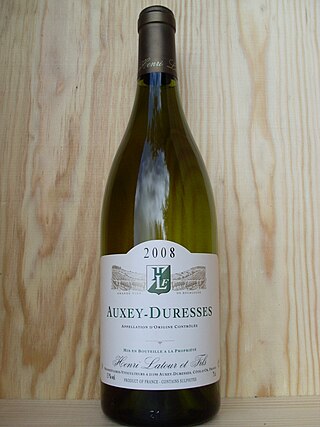
Auxey-Duresses wine is produced in the commune of Auxey-Duresses in Côte de Beaune of Burgundy. The Appellation d'origine contrôlée (AOC) Auxey-Duresses may be used for red and white wine with respectively Pinot noir and Chardonnay as the main grape variety. The production consists of around two-thirds red wine, and one-third white wine. There are no Grand Cru vineyards within Auxey-Duresses. The AOC Auxey-Duresses was created in 1970. Before the introduction of the appellation system in the 1930s, wines from this village were probably sold under the names of the more famous neighbors Volnay and Meursault. Later, the wines have been sold as Côte de Beaune-Villages, but it has progressively become more common to actually use the Auxey-Duresses AOC for the wines.

Monthélie wine is produced in the commune of Monthelie in Côte de Beaune of Burgundy. The Appellation d'origine contrôlée (AOC) Monthélie may be used for red and white wine with respectively Pinot noir and Chardonnay as the main grape variety. The production consists of more than 85% red wine, and less than 15% white wine. There are no Grand Cru vineyards within Monthelie.
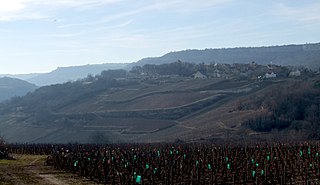
Saint-Romain wine is produced in the commune of Saint-Romain in Côte de Beaune of Burgundy. Rather than being situated on the main Côte d'Or escarpment, as most of the other Côte de Beaune wine villages, the vineyards of Saint-Romain are mainly located in a side valley to the west of Auxey-Duresses, in the direction of the communes and vineyards of the Hautes Côtes de Beaune. Most vineyards of Saint-Romain are located on slopes of various directions. The Appellation d'origine contrôlée (AOC) Saint-Romain may be used for red and white wine with respectively Pinot noir and Chardonnay as the main grape variety. A little more than half of the production consists of white wine. There are no Grand Cru and no Premier Cru vineyards within Saint-Romain.
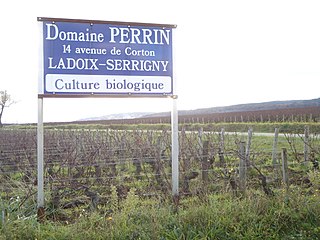
Ladoix wine is produced in the commune of Ladoix-Serrigny in Côte de Beaune of Burgundy, France. The Appellation d'origine contrôlée (AOC) Ladoix may be used for red and white wine with respectively Pinot noir and Chardonnay as the main grape variety. The production consists of around three-quarter red wine, and around one-quarter white wine. The northeastern part of the Corton hill is located in the commune of Ladoix-Serrigny, including vineyards of two of the three Grand Cru AOCs of the hill, Corton and Corton-Charlemagne. Some of the Premier Cru vineyards of Ladoix-Serrigny are part of the Aloxe-Corton AOC of the neighbouring village rather than of Ladoix AOC, and vinified and sold as Aloxe-Corton Premier Cru.

Chorey-les-Beaune wine is produced in the commune of Chorey-les-Beaune in Côte de Beaune of Burgundy. The Appellation d'origine contrôlée (AOC) Chorey-les-Beaune, which may also be written Chorey, may be used for red and white wine with respectively Pinot noir and Chardonnay as the main grape variety. More than 90 per cent of the production consists of red wine. There are no Grand Cru and no Premier Cru vineyards within Chorey-les-Beaune wine. Chorey-les-Beaune wine is sometimes declassified to Côte de Beaune-Villages, which is an appellation that allow négociants to sell wine blended from several villages. The AOC was created in 1970.

Savigny-lès-Beaune wine is produced in the commune of Savigny-lès-Beaune in Côte de Beaune of Burgundy. The Appellation d'origine contrôlée (AOC) Savigny-lès-Beaune may be used for red and white wine with respectively Pinot noir and Chardonnay as the main grape variety. The name of the appellation is sometimes written simply as Savigny, without the -lès-Beaune suffix. The production consists of slightly over 85 per cent red wine, and slightly less than 15 per cent white wine. There are no Grand Cru vineyards within Savigny-lès-Beaune.

Nuits-Saint-Georges wine is produced in the communes of Nuits-Saint-Georges and Premeaux-Prissey in the Côte de Nuits subregion of Burgundy. The Appellation d'origine contrôlée (AOC) Nuits-Saint-Georges may be used for red and white wine with respectively Pinot noir and Chardonnay as the main grape variety. The name of the appellation is sometimes written simply as Nuits, without the Saint-Georges part. The word "Nuits" has nothing to do with "nighttime" but comes from the Latin for walnuts, Nutium. The production of red wine dominates greatly, with around 97 per cent, and only around three per cent white wine. There are no Grand Cru vineyards within Nuits-Saint-Georges.

Fixin wine is produced in the communes of Fixin and Brochon in the Côte de Nuits subregion of Burgundy. The Appellation d'origine contrôlée (AOC) Fixin may be used for red and white wine with respectively Pinot noir and Chardonnay as the main grape variety. The production of red wine dominates greatly, with around 96 per cent, and only around four per cent white wine. There are no Grand Cru vineyards with these communes.
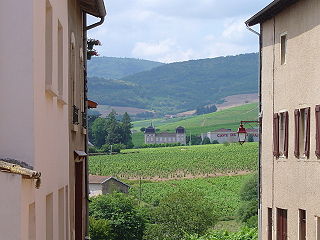
Juliénas is a French red wine AOC produced in the communes of Émeringes, Juliénas, and Jullié in the département of Rhône, and Pruzilly in Saône-et-Loire. The appellation covers the area of Juliénas, and is the most northerly of the Beaujolais crus of which all ten which are located in the northern half of the Beaujolais region. It is located on the north bank of the valley of the Mauvaise, a small tributary of the Saône. Juliénas obtained its AOC on the INAO decree of 11 March 1938. The wine takes its name from Julius Caesar who according to legend, was the source of the names of the communes Juliénas and Jullié, which were founded during his reign.



